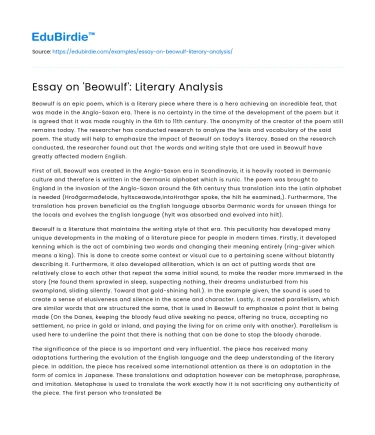Beowulf is an epic poem, which is a literary piece where there is a hero achieving an incredible feat, that was made in the Anglo-Saxon era. There is no certainty in the time of the development of the poem but it is agreed that it was made roughly in the 6th to 11th century. The anonymity of the creator of the poem still remains today. The researcher has conducted research to analyze the lexis and vocabulary of the said poem. The study will help to emphasize the impact of Beowulf on today’s literacy. Based on the research conducted, the researcher found out that The words and writing style that are used in Beowulf have greatly affected modern English.
First of all, Beowulf was created in the Anglo-Saxon era in Scandinavia, it is heavily rooted in Germanic culture and therefore is written in the Germanic alphabet which is runic. The poem was brought to England in the invasion of the Anglo-Saxon around the 6th century thus translation into the Latin alphabet is needed (Hroðgarmaðelode, hyltsceawode,intoHrothgar spoke, the hilt he examined,). Furthermore, The translation has proven beneficial as the English language absorbs Germanic words for unseen things for the locals and evolves the English language (hylt was absorbed and evolved into hilt).
Save your time!
We can take care of your essay
- Proper editing and formatting
- Free revision, title page, and bibliography
- Flexible prices and money-back guarantee
Beowulf is a literature that maintains the writing style of that era. This peculiarity has developed many unique developments in the making of a literature piece for people in modern times. Firstly, it developed kenning which is the act of combining two words and changing their meaning entirely (ring-giver which means a king). This is done to create some context or visual cue to a pertaining scene without blatantly describing it. Furthermore, it also developed alliteration, which is an act of putting words that are relatively close to each other that repeat the same initial sound, to make the reader more immersed in the story (He found them sprawled in sleep, suspecting nothing, their dreams undisturbed from his swampland, sliding silently. Toward that gold-shining hall.). In the example given, the sound is used to create a sense of elusiveness and silence in the scene and character. Lastly, it created parallelism, which are similar words that are structured the same, that is used in Beowulf to emphasize a point that is being made (On the Danes, keeping the bloody feud alive seeking no peace, offering no truce, accepting no settlement, no price in gold or inland, and paying the living for on crime only with another). Parallelism is used here to underline the point that there is nothing that can be done to stop the bloody charade.
The significance of the piece is so important and very influential. The piece has received many adaptations furthering the evolution of the English language and the deep understanding of the literary piece. In addition, the piece has received some international attention as there is an adaptation in the form of comics in Japanese. These translations and adaptation however can be metaphrase, paraphrase, and imitation. Metaphase is used to translate the work exactly how it is not sacrificing any authenticity of the piece. The first person who translated Beowulf John Mitchell used this method. Paraphrase is where the work's authenticity is kept in mind but the translator does not precisely follow the piece word by word. This method was done to Beowulf originally by John Gardner in the 19th century. Lastly, imitation is where the authenticity of the piece is not of its highest importance and the general idea is the one that is the most important.






 Stuck on your essay?
Stuck on your essay?

